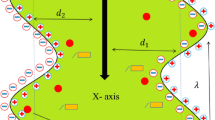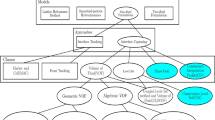Abstract
This paper investigated the improvement in the mixing process of a T-shape micromixer owing to the significance of the mixing process in the microfluidics system. The geometry of a micromixer inlets was numerically investigated in this study. To this end, six different geometries for the flow entrance were designed and their effects on the mixing phenomenon inside the microchannel were evaluated. The fluid flow was laminar and incompressible, and the Reynolds numbers ranged from 25 to 250. The flow governing equations, including continuity equations, Navier–Stokes, and mass transfer were discretized through the COMSOL Multiphysics commercial software. An index entitled "mixing cost" was defined with concern to the simultaneous effects of the mixing coefficient and pressure drop in a microchannel. The results revealed that the increase in the Reynolds number generally increased the mixing coefficient. However, the incidence of some specific conditions disturbed this general order. This issue was explored in detail and its reasons were reported in the paper. Results show that the dominant factors in the quality of mixing are location, magnitude, direction of rotation and the number of vortexes as well as the Reynolds number. Likewise, according to the results, the mixing intensity and mixing cost parameters should be simultaneously investigated. It is because an increase in the mixing coefficient does not generally and necessarily mean a decrease in the mixing cost. This issue was studied and evaluated in six conditions, and the results were reported. Compared to the condition number 1, condition number 3 enjoyed a 37% increase in the mixing intensity and a 9% decrease in the mixing cost in Re = 250.













Similar content being viewed by others
References
Ansari MA, Kim K-Y, Anwar K, Kim SM (2012) Vortex micro T-mixer with non-aligned inputs. Chem Eng J 181–182:846–850
Beebe DJ, Adrian RJ, Olsen MG, Stremler MA, Aref H, Jo B-H (2001) Passive mixing in microchannels: fabrication and flow experiments. Méc Ind 2(4):343–348
Cortes-Quiroz CA, Azarbadegan A, Zangeneh M (2014) Evaluation of flow characteristics that give higher mixing performance in the 3-D T-mixer versus the typical T-mixer. Sens Actuators B: Chem 202:1209–1219
Cortes-Quiroza CA, Azarbadegan A, Zangenehb M (2017) Effect of channel aspect ratio of 3-D T-mixer on flow patterns and convective mixing for a wide range of Reynolds number. Sens Actuators B: Chem 239:1153–1176
Danckwerts PV (1952) The definition and measurement of some characteristics of mixtures. Appl Sci Res Sect A 3(4):279–296
Dodge A, Jullien M-C, Lee Y-K, Niu X, Okkels F, Tabeling P (2004) An example of a chaotic micromixer: the cross-channel micromixerUn micromélangeur chaotique: le micromélangeur en croix. C R Phys 5(5):557–563
Dundi TM, Raju V, Chandramohan V (2019) Characterization of mixing in an optimized designed T–T mixer with cylindrical elements. Chin J Chem Eng. https://doi.org/10.1016/j.cjche.2019.01.030
Falk L, Commenge J-M (2010) Performance comparison of micromixers. Chem Eng Sci, 65(1)
Fani A, Camarri S, Salvetti MV (2013) Investigation of the steady engulfment regime in a three-dimensional T-mixer. Phys Fluids 25:064102
Feng X, Ren Y, Jiang H (2013) An effective splitting-and-recombination micromixer with self-rotated contact surface for wide Reynolds number range applications. Biomicrofluidics 7:054121
Feng X, Ren Y, Sun H, Chen X, Zhang K, Jia Y (2019) Effect of vortex on mass transport and mixing in microcapillary channels. Chem Eng J 362:442–452
Galletti C, Roudgar M, Brunazzi E, Mauri R (2012) Effect of inlet conditions on the engulfment pattern in a T-shaped micro-mixer. Chem Eng J 85:300–313
Habchi C, Lemenand T, Azizi F (2018) Mixing enhancement in a novel type of “Split and Recombine” Static Mixer. In ASME 2018 International Mechanical Engineering Congress and Exposition, Pittsburgh, Pennsylvania, USA, 208.
Heidari R, Khosroshahi AR, Sadri B, Esmaeilzadeh E (2019) The electrohydrodynamic mixer for producing homogenous emulsion of dielectric liquids. Colloids Surf A 578:123592. https://doi.org/10.1016/j.colsurfa.2019.123592
Hoffmann M, Schlüter M, Räbiger N (2006) Chem Eng Sci 61(9):2968–2976
Javaid MU, Cheema TA, Park CW (2018) Analysis of passive mixing in a serpentine microchannel with sinusoidal side walls. Micromachines (Basel), 9(1)
Kandlikar SG, Grande WJ (2003) Evolution of microchannel flow passages: Thermohydraulic performance and fabrication technology. Heat Transfer Eng 24(1):3–17
Kutter JP (2000) Current developments in electrophoretic and Current developments in electrophoretic and device. Trends Anal Chem 19:352–363
Lemoff AV, Lee AP (2000) An AC magnetohydrodynamic micropump. Sens Actuators B: Chem 63(3):178–185
Li T, Chen X (2017) Numerical investigation of 3D novel chaotic micromixers with obstacles. Int J Heat Mass Transf 115:278–282
Lin C-H, Tsai C-H, Fu L-M (2005) A rapid three-dimensional vortex micromixer utilizing self-rotation effects under low Reynolds number conditions. J Micromech Microeng 15:935–943
Lobasov AS, Minakov AV, Kuznetsov VV, Rudyak VY, Shebeleva AA (2018) Investigation of mixing efficiency and pressure drop in T-shaped micromixers. Chem Eng Process Process Intensif 134:105–114
Mouheb NA, Malsch D, Montillet A, Solliec C, Henkel T (2012) Numerical and experimental investigations of mixing in T-shaped and cross-shaped micromixers. Chem Eng Sci 68:278–289
Nguyen N-T, Wu Z (2004) Micromixers—a review. J Micromech Microeng 15(2):R1–R15
Nimafar M, Viktorov V, Matrinelli M (2012) Experimental comparative mixing performance and pressure drop simulation of three passive micromixers. Majlesi J Mechatron Syst 1(4):20–29
Pascal H, Jens T, Marko H, Michael S, Christian H, Patrick L, Dirk Z (2018) Optimization of a split and recombine micromixer by improved exploitation of secondary flows. Chem Eng J 334:1996–2003
Paul EL, Atiemo-Obeng VA, Kresta SM (2004) Handbook of industrial mixing. Wiley, Hoboken
Rabani R, Talebi S, Rabani M (2016) Numerical analysis of lamination effect in a vortex micro T-mixer with non-aligned inputs. Heat Mass Transf 52(3):611–619
Rahbarshahlan S, Esmaeilzadeh E, Khosroshahi AR, Ghaffarzadeh A (2020) Numerical simulation of fluid flow and heat transfer in microchannels with patterns of hydrophobic/hydrophilic walls. Eur Phys J Plus 135:157
Rahimi M, Akbari M, Parsamoghadam MA, Alsairafi AA (2015) CFD study on effect of channel confluence angle on fluid flow pattern in asymmetrical shaped microchannels. Comput Chem Eng 73:172–182
Soleymani A, Kolehmainen E, Turunen I (2008) Numerical and experimental investigations of liquid mixing in T-type micromixers. Chem Eng J 135:219–228
Stroock AD, Dertinger SK, Ajdari A, Mezić I, Stone HA, Whitesides G (2002) Chaotic mixer for microchannels. Science 295:647–651
Suh YK, Kang S (2010) A review on mixing in microfluidics. Micromachines 1:82–111
Veenstra TT, Lammerink TSJ, Elwenspoek MC, Berg AVD (1999) Characterization method for a new diffusion mixer applicable in micro flow injection analysis systems. J Micromech Microeng 9(2):199–202
Viktorov V, Mahmud MR, Visconte C (2015) Numerical study of fluid mixing at different inlet flow-rate ratios in Tear-drop and Chain micromixers compared to a new H-C passive micromixer. Eng Appl Comput Fluid Mech 10(1):182–192
Wong SH, Ward MC, Wharton CW (2004) Micro T-mixer as a rapid mixing micromixer. Sens Actuators B 100:359–379
Wu Z, Nguyen N-T, Huang X (2004) Nonlinear diffusive mixing in microchannels: theory and experiments. J Micromech Microeng 14(4):604–611
Yang Z, Goto H, Matsumoto M, Maeda R (2000) Active micromixer for microfluidic systems using lead-zirconate-titanate (PZT)-generated ultrasonic vibration. Electrophoresis 1:116–119
Yang R, Williams JD, Wang W (2004) A rapid micro-mixer/reactor based on arrays of spatially impinging micro-jets. J Micromech Microeng 14:1345–1351
Author information
Authors and Affiliations
Corresponding author
Ethics declarations
Conflict of interest
The authors declare that they have no conflict of interest.
Additional information
Publisher's Note
Springer Nature remains neutral with regard to jurisdictional claims in published maps and institutional affiliations.
Rights and permissions
About this article
Cite this article
Rahbarshahlan, S., Ghaffarzadeh Bakhshayesh, A., Rostamzadeh Khosroshahi, A. et al. Interface study of the fluids in passive micromixers by altering the geometry of inlets. Microsyst Technol 27, 2791–2802 (2021). https://doi.org/10.1007/s00542-020-05067-2
Received:
Accepted:
Published:
Issue Date:
DOI: https://doi.org/10.1007/s00542-020-05067-2




